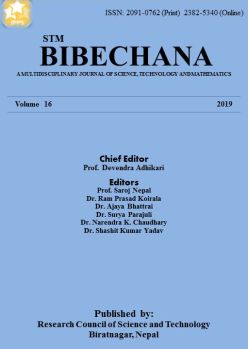Molecular dynamics approach to the I431V mutational impact on thyroid hormone receptor-beta
DOI:
https://doi.org/10.3126/bibechana.v16i0.21109Keywords:
Thyroid hormone receptor, resistance to thyroid hormones, point mutation, interaction energy, internal energyAbstract
The point mutations like I431V on thyroid hormone receptor-beta (THR-β) gene cause resistance to thyroid hormones (RTH) with the clinical diagnosis of elevated free triiodothyronine (T3) and free thyroxin (T4) but not suppressed thyroid stimulating hormone (TSH) on the blood serum. Some ultrasonographic (USG) reports of the patients with RTH show thyroid gland disorder with goiter or nodule(s) or cyst(s) and some USG reports even with RTH are normal. I431V-mutant causes more steric hindrance while binding T3 into THR-β than the native wild type THRT3. The residue on the 431-codon is dynamic in nature showing its flexibility over the course of entry and release of T3-hormone into/from the ligand binding pocket. The more increased solvent accessible surface area of I431V-mutant than that of native I431-residue makes the partial unfolding of the globular THR-β protein. The smaller height of radial distribution function between I431-mutant and T3 shows the decrease in probability of finding the atomic particles nearby T3-hormone in THRT3-MT than in THRT3-WT. The electrostatic interaction energy between native I431 and T3 is negative, but it is positive between I431V and T3. Moreover, the internal energy of I431V-mutant has been found smaller than that of native I431-residue in THRT3 systems.
BIBECHANA 16 (2019) 79-91
Downloads
Downloads
Published
How to Cite
Issue
Section
License
This license enables reusers to distribute, remix, adapt, and build upon the material in any medium or format for noncommercial purposes only, and only so long as attribution is given to the creator.




